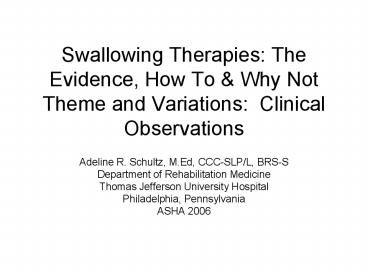Swallowing Therapies: The Evidence, How To - PowerPoint PPT Presentation
1 / 19
Title:
Swallowing Therapies: The Evidence, How To
Description:
... flexion of the cervical spine with chin down to chest 'Look at your belly button.' Chin pulled back toward spine like a military stance cervical spine is ... – PowerPoint PPT presentation
Number of Views:123
Avg rating:3.0/5.0
Title: Swallowing Therapies: The Evidence, How To
1
Swallowing Therapies The Evidence, How To Why
NotTheme and Variations Clinical Observations
- Adeline R. Schultz, M.Ed, CCC-SLP/L, BRS-S
- Department of Rehabilitation Medicine
- Thomas Jefferson University Hospital
- Philadelphia, Pennsylvania
- ASHA 2006
2
Chin Tuck
- What kind of chin tuck do you instruct patients
to use? - Total flexion of the cervical spine with chin
down to chest Look at your belly button. - Chin pulled back toward spine like a military
stance cervical spine is straight - Head flexed but in fairly neutral position
Look down at you knees.
3
Head in Extension
- Patients with spinal cord injury with head
immobilized in a halo - Patients post spinal surgery for anterior
cervical fusion in hard collar - Patients after head and neck surgery with poor
oral stage function. Head extended to let
gravity move bolus back in oral cavity
4
Breath Hold Controlled Swallow
- Variation of the Supra-Glottic Swallow
- Combination of the breath hold, preparatory set
and effortful swallow - Directions
- Hold liquid or chewed food in mouth, but dont
swallow. - Breathe in through nose, hold your breath.
- Swallow one or two times.
- Breathe out.
5
- Helps patient to feel as though s/he has some
control over swallow initiation - Patient can breathe back out through nose if
unable to initiate the swallow, and try again,
while still containing the bolus in the mouth - Helps with oral retention
- Helps to organize the swallow
6
- Provides for a stronger pharyngeal contraction
- Gives patients a sense of control to cough out if
worried about choking - Patients must be able to follow 3-4 directions
in a sequence - Start with swallow of own saliva, and work up to
foods that are feared or difficult
7
Patients who have a fear of swallowing
- Patients who have previously choked
- Patients who have pain upon swallowing
- Patients who have difficulty initiating and/or
coordinating the swallow - Patients who cannot take pills or capsules
8
Patients who have pain upon swallowing
- Post or during Radiation Therapy
- Post head and neck surgery
- Post surgery for Anterior Cervical Fusion
- Post extubation
9
Other Patient Populations
- Paralysis of one or both vocal folds
- Paradoxical Vocal Fold Dysfunction or Spasms
- Esophageal dysmotility and reflux
- Neurological conditions causing inco-ordination
of the swallow
10
Variation of Masako
- Pharyngeal Wall strengthening
- Without food or liquid
- Stick your tongue out as far as it will go, bite
on tongue to stabilize, now try to swallow. - Variation to make it harder Stick your tongue
out as far as it will go, and swallow with your
mouth open.
11
Lee Silverman Voice Therapy
- Extensively researched for Parkinsons patients
- Current research with other types of dysarthric
patients for improved volume, improved vocal fold
function and improved articulation - Improved strength and coordination of swallowing
12
Organic Bases for Functional Swallowing Problems
- Pulmonary
- Reflux and GI related
- Post-Traumatic Event or Surgery
- Post-intubation
- Aneurexia/bulemia
- Irritable Larynx/Neurogenic cough
13
Holistic Approach
- Relaxation Techniques, Stress Management and
Guided Imagery - Self-Hypnosis with rehearsal for swallowing
different foods/textures and medications - Referral for counseling or psychotherapy
- Life style, behavioral and dietary modifications
for GERD and LPR
14
- Physician prescribed medications such as Proton
Pump Inhibitors (PPIs), anti-spasm medications,
and BoTox - Medical Interventions such as Esophageal
Dilitation - Hierarchical introduction of foods, from the
easiest to the most feared - Feared foods eaten in treatment session
15
Food Journals
- What was tried
- Amounts
- Time it took to eat
- Any difficulty with the swallow
- This log can also be shared with the nutritionist
- Helps the patient to see progress
16
Bibliography Stress Management, Meditation and
Self-Hypnosis
- Kabat-Zinn, J, (2005 Re-issue), Full Catastrophe
Living Using the Wisdom of your Body and Mind to
Face Stress, Pain, and Illness, Bantam Dell, A
Division of Random House, Inc., New York, New
York - Kabat-Zinn, J (2005), Coming to Our Senses
Healing Ourselves and the World Through
Mindfulness, Hyperion, New York, New York
17
- Alman, BM, (1992), Self-Hypnosis the Complete
Manual for Health and Self-Change, 2nd Edition,
Routledge, New York, New York - Hunter, ME (1994), Creative Scripts for
Hypnotherapy, Bruner-Mazel, Inc., United Kingdom - Weil, A, Gurgevich, S, Heal Yourself with Medical
Hypnosis, (2005), Self-Healing, Mt. Morris,
Illinois
18
Bibliography Nutrition Websites and Texts
- www.dysphagiabooks.com Site for ordering
dysphagia books for texture modifications - www.dysphagia-diet.com Site with links to
companies who carry dysphagia products - www.eatright.org American Dietetic
Associations web site. Includes the National
Dysphagia Diet. - www.hciglobal.org Healthcare Caterers
International. Educational resources on
dysphagia. - www.novartisnutrition.com Novartis Medical
Nutrition - www.oley.org The Oley Foundation. Information
and support for patients on IV and tube feedings. - Worthington,P, Practical Aspects of Nutritional
Support, (2004), Elsevier, Philadelphia.
19
Bibliography Dysphagia Treatment
- Huckabee,ML, Pelletier, CA (1999), Management of
Adult Neurogenic Dysphagia, Singular, San Diego,
29-50 - Logemann, JA, (1998) Evaluation and Treatment of
Swallowing Disorders, Pro-Ed, Austin, 205-240 - Murry, T, Carrau, RL, (2006), Clinical Management
of Swallowing Disorders, Plural Publishing, San
Diego, 139-167































